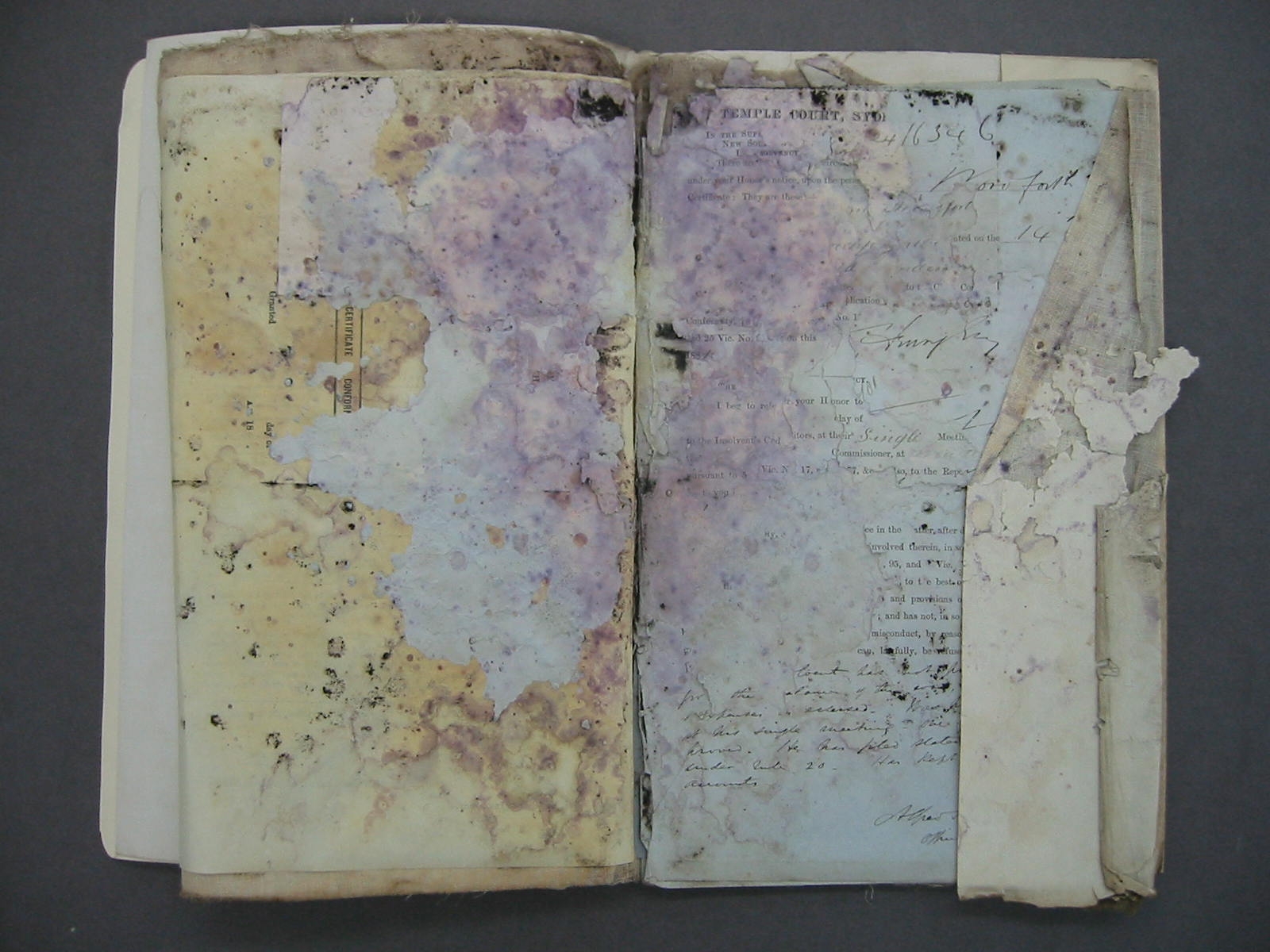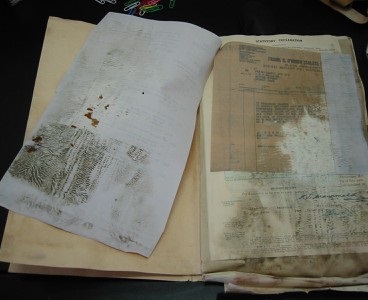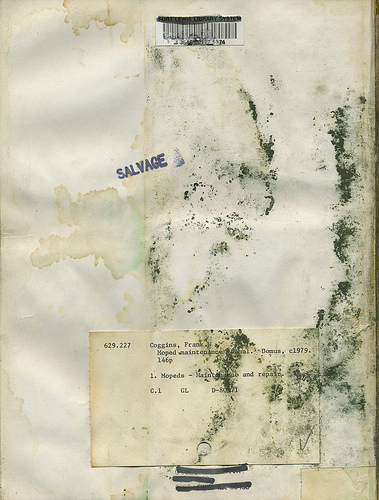A regular maintenance and monitoring program for records storage areas has been implemented. (Principle 4)
Records storage areas and facilities should be regularly monitored and well maintained to ensure that they continue to provide a stable and suitable environment for records. Planned maintenance programs can prevent many storage problems.
A maintenance and monitoring program for records storage areas and facilities should be part of the organisation’s building maintenance program. Additionally, records and containers in storage should also be monitored for signs of pest infestation, mould or other deterioration. If mould or pest infestation is identified, it should be treated promptly and appropriately. Conservation treatments should be undertaken as required and only if they are not likely to damage the records further.
The building, equipment and services should always be maintained to approved standards, legislation and building codes. If contractors are used for building maintenance the contract should include provision for the factors listed below and the contractor’s performance assessed regularly.
6.1 Maintenance and monitoring programs
Maintenance and monitoring programs for records storage involve inspecting and mitigating any issues identified with:
- changes in environmental conditions, including light and pollution levels, temperature and humidity
- potential disaster incidents, e.g. following storm events
- presence of mould and/or pest infestation
- building surrounds and fabric
- physical security of buildings, storage areas, and security zones within storage areas
- internal factors, including electrical equipment and pipes, and structures like shelving, to ensure that they are safe and in good condition
- cleanliness of storage areas
- fire detection mechanisms such as alarms, smoke detectors, sprinkler systems and extinguishers to ensure they are working correctly
- other identified risks that need to be managed, and
- any new risks that may arise.
If the public office uses a commercial facility, arrangements should be made with the storage provider for reports to be provided on inspections of the storage areas and facility housing State records, and advice on any mitigation actions that have been undertaken to address any issues or risks.
6.2 Building maintenance and pest inspections
Building maintenance and pest inspections should be undertaken on a regular basis. Depending on the organisation, this may be undertaken in association with workplace health and safety inspections. Reports of inspections should be captured into the recordkeeping system as evidence of compliance with this requirement of the standard.
Any risks found should be either removed or minimised to reduce their severity.
Inspections should include the following:
- buildings and storage areas
- security
- environmental conditions
- shelving equipment and containers
- pests
- fire suppression and prevention, and
- cleanliness.
Each of these is discussed in more detail below.
Buildings and storage areas
Monitoring the building’s exterior includes regularly inspecting the building and its surrounds. Things to particularly look out for are:
- cracks or dampness in walls
- flaky paint/plaster
- signs of water leaks, spillages, blockages in drains, roofs or gutters
- corrosion
- signs of pest infestation
- mould
- signs of damage or unlawful entry, such as vandalism or broken windows, and
- signs of new risks.
Regular inspections should also be made of the building’s interior and storage areas to ensure that there are none of the above. All risks or problems should be fixed or managed to reduce their severity.
Security
Monitoring and maintenance of security measures may involve checking and assessing alarms, motion detectors, cameras, surveillance equipment, locks and other access controls, and checking for new security risks. Measures may need to be taken if there are problems. For example, if an alarm is temporarily disabled, the organisation may wish to employ a guard or a regular patrol until the alarm is repaired.
If security firms are used, their performance should be monitored and, if unsatisfactory, a plan for improvement or the replacement of the firm be considered.
Environmental conditions
The storage area should be inspected regularly to identify perceptible changes in the environment, such as temperature and humidity fluctuations. The frequency of monitoring and inspections should increase if an irregularity is discovered or if there has been bad weather, severe storms, high temperatures or humidity, or high winds. Temperature and humidity levels must be maintained and you may need to implement additional measures to ensure that the storage areas continue to meet the acceptable levels outlined in Section 4 Environmental conditions.
Measures to combat temperature and humidity fluctuations include installing insulation, improving the building so it is sealed, or using fans or heaters. Areas can be dehumidified by using portable dehumidifiers or moisture absorbing crystals. [23] If the problem persists it may be necessary to remove the records.
The following should be used to monitor conditions in the storage area/facility, and particularly if you are storing long term termporary records, State archives, computer disks and tapes or large quantities of audio visual material:
- whirling hygrometers, also known as psychrometers, which may be used for regular monitoring programs and more intensively when there is concern about environmental conditions. The advantages of these devices are that they are accurate, easily portable and less expensive than thermohygrographs.
- thermohygrographs, sometimes known as hygrothermographs. The main advantage of these machines is that they record temperature and humidity levels continuously, allowing the stability of the environment to be assessed. They indicate patterns of the environmental control. They also produce charts which can be retained as a permanent record of performance, and they provide the basis of diagnosing problems with air conditioning equipment. They are delicate scientific instruments which need to be treated carefully and require recalibrating occasionally. These machines are expensive to purchase although they may be sometimes obtained by hire from larger archives and museums.
- building management systems (BMS). These electronic programs are a feature of modern buildings and monitor vital elements such as temperature and humidity, security, fire protection, lighting and air quality. If needed, conditions may be monitored from remote locations. Purpose-built repositories, especially those which are intended for a large proportion of records of long term and continuing value, should investigate building management systems.
- data loggers. These are compact temperature and humidity monitors which print readings out onto graphs. Information can be downloaded to a PC. These tend to be cheaper than thermohygrographs.
- hand held probes and recorders. [24]
Air conditioning systems must also be regularly monitored and maintained, and filters changed.
Maintenance of lights should involve checking light globes to ensure they are working correctly. The light level may be measured by a luxmetre or by a building management system (see above).
Shelving equipment and containers
Staff should also examine the components of storage areas. Manual shelving may require some maintenance work, for example, the replacement of operating handles. If shelving is electrically operated, the motors will need to be maintained regularly. [25]
Equipment, such as trolleys and ladders, will also require monitoring and maintenance to ensure they are maintained in good condition. Any faulty shelving or equipment that cannot be adequately maintained should be replaced.
Damaged or dirty containers should be replaced promptly. The records will then remain protected.
Pests and vermin
Inspections should look for the presence of pests and vermin within the storage area and facility. Darker and warmer sections of the storage area in particular should be inspected regularly. Evidence of pests and vermin will be obvious: there will be droppings and regurgitated food, and evidence of nesting (rats and mice use paper records for nesting sites).
If baits, traps, powders and/or sprays have been used, their effectiveness should be monitored.
Fire prevention and suppression
Part of the inspection process for buildings and storage areas should be to check fire prevention and suppression mechanisms. Inspections should include:
- emergency exits to ensure they are free of obstacles
- fire extinguishers to ensure they are in position, labelled and fully operational
- storage areas to ensure that combustible materials, such as chemicals or cellulose nitrate film, are not present
- sprinklers to ensure they are fully operational, and
- electrical wiring for signs of deterioration.
Part of the maintenance and monitoring process should also be ensuring that staff skills in fire prevention and suppression are up to date.
Cleanliness
Inspections should monitor the effectiveness of cleaning operations. Buildings, storage areas and shelving should be cleaned on a regular basis. Storage areas should be cleaned regularly with a vacuum cleaner fitted with a HEPA filter (high efficiency particulate air filter) to remove dust particles.
Cleaning agents should not harm the materials stored. Agents containing ammonia and bleaches should be avoided as the vapours they give off can cause paper to oxidate, leaving brown marks. Some environmentally friendly cleaners may be used if they are not too strong. Alternatively water, or water and vinegar solutions can be used.
6.3 Records inspections
Regular inspections should also be made of the records themselves. Records can be monitored for signs of:
- infestation by insects or vermin
- mould
- dust
- corrosion
- damage, such as rips and tears, or
- other forms of deterioration.
It is important when monitoring records within storage areas and facilities, that a range of boxes, containers and storage equipment (such as plan drawers) are sampled across the storage area / facility to identify environmental issues which may be occurring in ‘pockets’ of the storage area / facility.
It is very important that boxes, containers etc are opened and the physical condition of the records checked. This is the only way to check what might be occurring in the box, e.g. mould or pest infestations.
Staff who regularly work in storage areas or facilities should receive training in identifying potential risks to records and records which may require conservation treatments. Staff and users should also be encouraged to report the existence of signs of deterioration in records or record containers.
6.4 Identifying and responding to mould infestations
Mould is a type of fungus and is perhaps the most serious pest which can affect records collections because it spreads rapidly and can destroy the records it attacks. Signs of mould include brown marks, furry stains, a dusty substance, mildew-like growth on paper, white fluffy substance, and a musty odour. Mould “will cause staining, weakening of paper, and in the worst cases will completely devour it.”[26] See Conservation Tip 5 for examples of mould on records and how to manage mould outbreaks (https://www.records.nsw.gov.au/archives/collections-and-research/guides-and-indexes/conservation-tip-05-removing-mould)

Mould on records source: NSW State Archives and Records

Mould on records source: NSW State Archives and Records

Mould on records source: http://www.flickr.com/photos/mr_carl/2348573021/
There is high potential for mould growth once the relative humidity exceeds 60%. Thus, every attempt must be made to keep humidity below 60%, minimise fluctuations in humidity, and ensure that storage areas have good ventilation.
If you find mould on records, you will need to QUICKLY determine the extent of the problem in order to best identify how to deal with the problem and to determine if it is possible to isolate affected records from the rest of the records in storage.
Remember, there are health and safety issues with dealing with mould. Personal protective equipment (PPE), including dust masks, plastic gloves, and eye goggles should be worn.
If you have a small quantity of records affected by mould (just several items):
- place records into plastic bags or air-tight plastic tubs and remove them to a dry, well-ventilated space where they can be cleaned. Do not transport them to another location unless they are in air-tight plastic bags or plastic tubs.
- follow instructions from NSW State Archives and Records for cleaning records and seek professional conservation/recovery assistance
- check that storage environment conditions are not conducive to mould growth (i.e. the humidity should be below 60% RH)
- ensure that Personal Protective Equipment (PPE) is worn and that any cleaning occurs in a well ventilated space and using a fume hood. [27]
If you have a larger quantity of records affected by mould:
- check that storage environment conditions are not conducive to mould growth (i.e. the humidity is below 60%)
- assess whether it’s possible to isolate the affected records (this may be possible if the quantity is not too great),
- follow instructions from NSW State Archives and Records for cleaning records and seek professional conservation/recovery assistance
In addition to cleaning the records, you will also need to clean the storage shelves:
- vacuum the shelves
- wipe them with a 70% solution of Methylated Spirit or Ethanol, and
- let the shelves dry.
Before returning records to the storage area, you must make sure that the environmental conditions are appropriate in the storage space and that humidity levels are below 60%.
6.5 Identifying and responding to pest infestations
If you do find evidence of pest activity such as silverfish, termites, cockroaches etc., you will need to identify:
- the source of the problem and the severity of the activity
- if records have been affected by pest activity, and
- if affected records are short/medium temporary records, long term temporary records or State archives.
Remember, there are health and safety issues with records infested by insects/insect eggs/faecal matter. Personal protective equipment (PPE), including masks with either a P1 or P2 filter, plastic gloves, apron, and eye goggles should be worn when handling pest infested records.
6.6 Repairs to records
Repairs to records should be undertaken where necessary and only if they are not likely to damage the records further. Repairs to records should only be carried out under the supervision of a Conservator and in consultation with NSW State Archives and Records.
6.7 Keeping records about maintenance and monitoring
It is important to keep records about the maintenance and monitoring of records storage. Examples of the types of documentation the organisation may have are:
- building maintenance and pest inspections of storage areas/facilities used by the public office, include commercial storage facilities
- integrated pest management program documentation, including information on treatments undertaken to remove pest infestation
- maintenance undertaken to mitigate risks to records
- inspections of records, and reports identifying any records or containers which have signs of pest infestation, mould, or other deterioration
- corrective and preventative work undertaken to ensure that the storage areas and facilities are compliant with Standard
- procedures for responding to mould or pest infestation affecting records
- documentation of notification to NSW State Archives and Records of mould or pest infestations affecting records and agreement on the proposed treatments/repairs to records
- registers of any repair or conservation work undertaken, and
- conservation reports.
If maintenance is part of a contract, contractors should report on surveys and work undertaken for maintenance. These records should reside with the organisation to show that the contractor is meeting their obligations and that the organisation is meeting its requirements.
[23] Ling, Solid, Safe, Secure, p.115
[24] Ling, Solid, Safe, Secure, p.115
[25] Ling, Solid, Safe, Secure, p.94
[26] Hadlow, “Preservation”, pp.117 - 118
[27] NSW State Archives and Records, Conservation Tip No. 5 Removing mould from records and archives, available at https://www.records.nsw.gov.au/archives/collections-and-research/guides-and-indexes/conservation-tip-05-removing-mould

